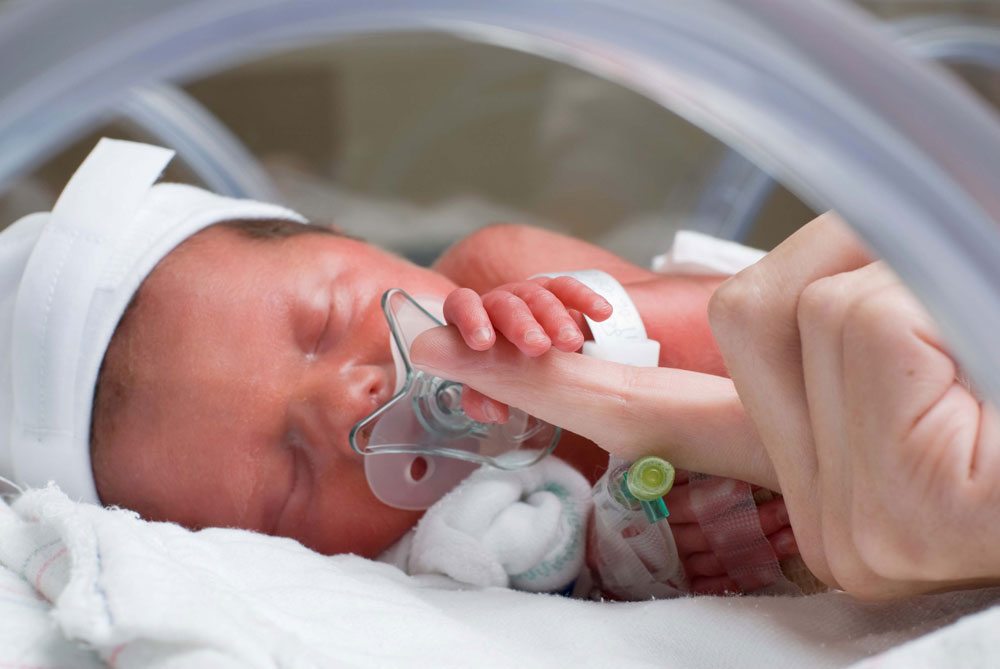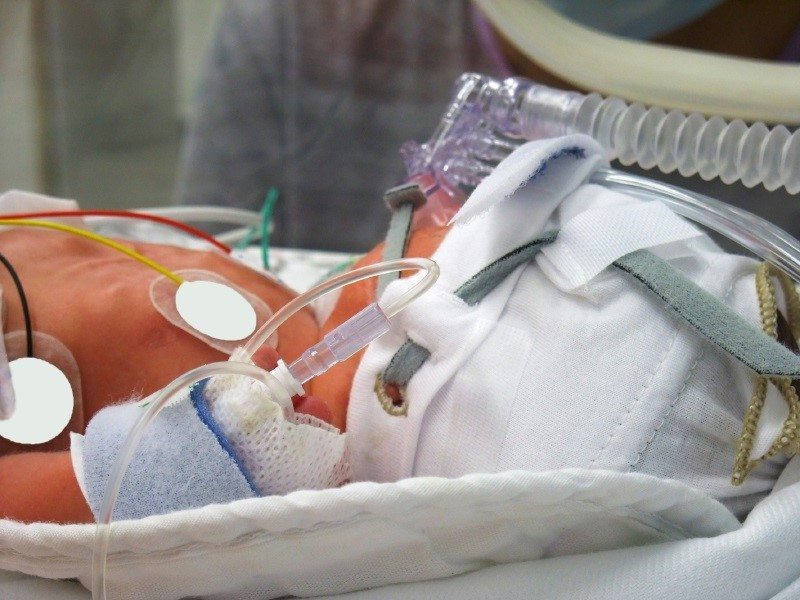Cerebral Palsy Caused by Neonatal Encephalopathy (Brain Damage in Newborn Babies)
Neonatal encephalopathy (NE) is a form of infant brain damage that results from any insult to a baby’s developing brain. Occurring at or after 35 gestational weeks, neonatal encephalopathy is most commonly the result of hypoxic ischemic encephalopathy (HIE; birth asphyxia), a form of brain injury that occurs when a newborn receives insufficient levels of oxygen to the brain around the time of delivery. However, other known causes of neonatal encephalopathy include maternal infection, fetal stroke, intracranial hemorrhages (brain bleeds), meningoencephalitis (encephalitis and meningitis), and any other pregnancy or delivery complication interfering with normal brain development. Neonatal encephalopathy often results in cerebral palsy (CP), seizures and epilepsy, hydrocephalus, microcephaly, periventricular leukomalacia (PVL), and other disorders.
If your child was diagnosed with cerebral palsy or another disabling condition from neonatal encephalopathy, he or she may have grounds for a medical malpractice claim. Unlike other law firms, the lawyers at Michigan Cerebral Palsy Attorneys specialize solely in birth injury cases. Complete our contact form or call our Michigan cerebral palsy lawyers toll-free at (888) 592-1857 for your free legal consultation. Or legal experts will answer your legal questions and determine if medical malpractice was at the root of your child’s neonatal encephalopathy diagnosis.
What Injuries are Associated with Neonatal Encephalopathy?
 Because the severity of a baby’s birth asphyxia varies so greatly, the injuries associated with neonatal encephalopathy can be very different from patient to patient. In mild or quickly treated cases of neonatal encephalopathy, the brain doesn’t swell enough to cause lasting damage. However, when cases of neonatal encephalopathy are more severe or are left untreated, babies often develop the following permanent injuries and conditions:
Because the severity of a baby’s birth asphyxia varies so greatly, the injuries associated with neonatal encephalopathy can be very different from patient to patient. In mild or quickly treated cases of neonatal encephalopathy, the brain doesn’t swell enough to cause lasting damage. However, when cases of neonatal encephalopathy are more severe or are left untreated, babies often develop the following permanent injuries and conditions:
- Cerebral palsy
- Epilepsy and seizure conditions
- Cognitive impairments
- Neurodevelopmental deficits and developmental delays
- Motor function impairments
- Fetal death
What Causes Neonatal Encephalopathy?
Any insult to the brain that causes cerebral inflammation can cause neonatal encephalopathy—most commonly, these injuries include hypoxic ischemic encephalopathy (HIE), brain bleeds, maternal infections, and strokes. Below we’ve listed the known causes of neonatal encephalopathy in more detail:
Birth asphyxia: Birth asphyxia, or a lack of oxygen to the baby’s brain, is the primary cause of neonatal encephalopathy. Because neonates receive oxygenated and nutrient-rich blood from the placenta, any interference to the placenta or umbilical cord compromises fetal oxygen intake. Furthermore, if the mother suffers from oxygen deprivation, the baby will suffer oxygen deprivation. Below, we’ve listed conditions, injuries, and other problems that cause result in a diminished flow of oxygen to a baby’s brain:
- Delayed emergency C-section: The failure to perform a quick Cesarean section operation in the case of fetal distress may lead to prolonged oxygen deprivation and result in neonatal encephalopathy.
- Preeclampsia: Pregnancy-induced high blood pressure in the mother may constrict blood vessels in the placenta and compromise blood flow to the baby.
- Placental abruption: Placental abruption, which occurs when the placenta fully or partially separates from the uterus, interferes with placental functioning and may cause fetal oxygen deprivation.
- Placental insufficiency (uteroplacental insufficiency): Fetal oxygen deprivation and neonatal encephalopathy may occur from any interference to the placenta’s function or productivity.
- Umbilical cord problems: Umbilical cord prolapse, umbilical cord compression, nuchal cords, short umbilical cords, or a true knot in the umbilical cord are all conditions that interfere with the umbilical cord’s ability to adequately transport oxygenated blood to the baby. The presence of umbilical cord problems may result in birth asphyxia and neonatal encephalopathy.
- Placental previa, a pregnancy complication in which the placenta partially or fully blocks the opening of the birth canal, can result in delivery situations that compromise fetal oxygen intake.
- Fetal strokes occur when the blood vessels in a baby’s brain are blocked or constricted. Strokes may cause brain damage, cerebral inflammation, and neonatal encephalopathy.
- Premature rupture of the membranes (PROM) may cause infection and preterm birth, which both can lead to neonatal encephalopathy.
- Prolonged or arrested labor often results in the traumatic, oxygen-depriving situations that lead to neonatal encephalopathy.
- Hyperstimulation of the uterus from the labor-inducing drugs Pitocin and Cytotec can limit the flow of oxygen to a baby’s brain and cause neonatal encephalopathy.
- Uterine rupture occurs when the uterus tears open. When this occurs, the baby may suffer oxygen deprivation in two ways—for one, maternal blood loss from the injury may compromise blood flow to the baby. Secondly, uterine rupture may cause the placenta to separate from the circulation of the mother.
- Abnormal fetal size and malpresentation often result in prolonged, arrested, or traumatic deliveries. Cephalopelvic disproportion (CPD), breech presentation, face presentation, and macrosomia may result in neonatal encephalopathy.
- Post term pregnancies (pregnancies progressing beyond 37 gestational weeks) often see diminished placental productivity, which ultimately increases the risk for neonatal encephalopathy.
- Polyhydramnios (excessive amniotic fluid) and oligohydramnios (insufficient amniotic fluid levels) often result in umbilical cord problems, fetal growth abnormalities, and other conditions that may result in neonatal encephalopathy.
- Anesthesia mistakes may interrupt maternal oxygen intake, thus compromising fetal oxygen levels.
- Intracranial hemorrhages, also known as brain bleeds, are a common cause of brain damage and neonatal encephalopathy. During labor and delivery, brain bleeds may be caused by the misuse of vacuum extractors or forceps, the mismanagement of a baby in the breech presentation, the mismanagement of macrosomia or cephalopelvic disproportion, trauma from prolonged labor, hypoxic ischemic encephalopathy (HIE), or abnormal changes in blood pressure.
- Other causes of neonatal encephalopathy include the improper management of a baby’s respiration after birth, improper management of anemia after birth, and fetal heart monitoring errors.
What are the Signs and Symptoms of Neonatal Encephalopathy?
Neonatal encephalopathy is often accompanied by the following signs and symptoms:
- Low Apgar scores
- Seizures
- Feeding difficulties
- Extreme metabolic acidemia or mixed acidemia
- The need for infant resuscitation after delivery
- Hypotonia (decreased muscle tone)
- Decreased muscle power
- Organ dysfunction
- Absent brain stem reflexes
- Coma
How is Neonatal Encephalopathy Diagnosed?
When a baby suffers any of the known causes of neonatal encephalopathy, changes to his or her heart rate will occur and physicians will perform diagnostic tests to confirm or deny the presence of a hypoxic ischemic insult. Furthermore, seizures, organ dysfunction, and other indicators of neonatal encephalopathy may be present after delivery. In order to decrease the severity and permanence of neonatal encephalopathy, physicians must thoroughly monitory the baby for signs of neonatal encephalopathy. Diagnostic tests include CT scans, PET scans, EEGs, MRIs, blood glucose tests, ultrasounds, and arterial blood gas tests. Unfortunately, neonatal encephalopathy often does not become evident until later in a child’s life when he or she experiences disabling conditions or developmental delays.
How is Neonatal Encephalopathy Treated?
The most promising treatment for infants with neonatal encephalopathy is the hypothermia treatment. Hypothermia treatment, which must begin within six hours of the baby’s brain insult, consists of lowering the infant’s body temperature down to 91 degrees Fahrenheit for roughly 72 hours. The hypothermia treatment diminishes the permanence and severity of neurological damage by slowing the body’s metabolic rate down enough for brain cells to recuperate. In order for a newborn baby to be eligible for hypothermia treatment, he or she must be at least 36 weeks old, have suffered the brain injury within 6 hours of the onset of treatment, and exhibit no contraindications for the treatment.
Besides hypothermia treatment, treatment for neonatal encephalopathy is largely supportive or complementary. Individuals with permanent brain damage from neonatal encephalopathy participate in therapy programs aimed towards improving the physical, mental, emotional, and social conditions and disabilities resulting from the brain damage.
Legal Help for Neonatal Encephalopathy (NE) and Cerebral Palsy (CP)
The neonatal encephalopathy lawyers at Michigan Cerebral Palsy Attorneys have decades of specific, thorough experience with birth trauma cases and will determine whether or not medical malpractice caused your child’s injury. For reference, the following scenarios are instances of medical malpractice:
- Failure to treat, diagnose, and control maternal/fetal infections or complications that are known to cause neonatal encephalopathy
- Failure to thoroughly monitor and treat maternal and fetal conditions during pregnancy, labor, and delivery
- Failure to recognize fetal distress signals during delivery and/or failure to treat fetal distress during delivery
- Failure to properly diagnose the risk factors, causes, signs, and symptoms of neonatal encephalopathy
If you know a child whose cerebral palsy or disabling condition resulted from neonatal encephalopathy, birth asphyxia, hypoxic ischemic encephalopathy, or another birth injury, our Michigan birth trauma lawyers encourage you to reach out for help today. We help victims of medical malpractice and their families from Detroit, Lansing, Dearborn, Warren, Sterling Heights, Ann Arbor, Grand Rapids, Flint, and all other Michigan cities. Call Michigan Cerebral Palsy Attorneys toll-free at (888) 592-1857 or fill out our online contact form here.
